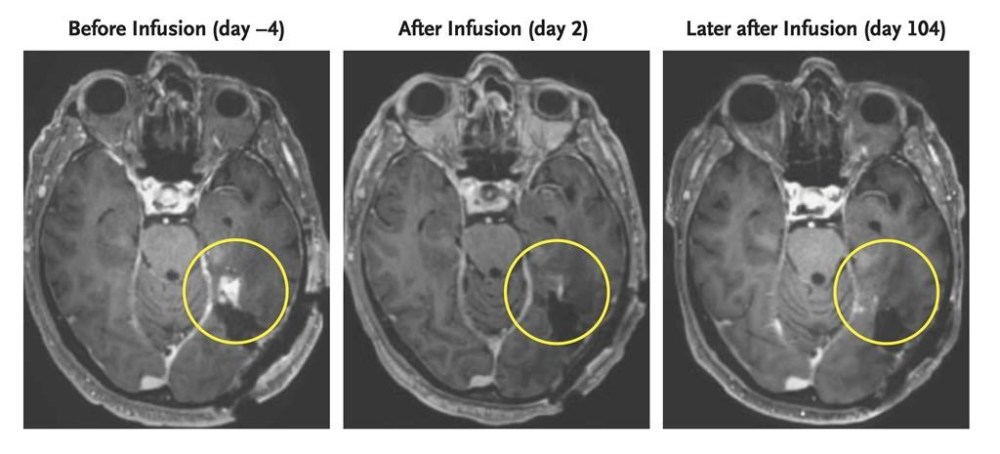A new strategy to attack aggressive brain cancer shrank tumors in two early tests
Advertisement
Read this article for free:
or
Already have an account? Log in here »
To continue reading, please subscribe:
Monthly Digital Subscription
$0 for the first 4 weeks*
- Enjoy unlimited reading on winnipegfreepress.com
- Read the E-Edition, our digital replica newspaper
- Access News Break, our award-winning app
- Play interactive puzzles
*No charge for 4 weeks then price increases to the regular rate of $19.00 plus GST every four weeks. Offer available to new and qualified returning subscribers only. Cancel any time.
Monthly Digital Subscription
$4.75/week*
- Enjoy unlimited reading on winnipegfreepress.com
- Read the E-Edition, our digital replica newspaper
- Access News Break, our award-winning app
- Play interactive puzzles
*Billed as $19 plus GST every four weeks. Cancel any time.
To continue reading, please subscribe:
Add Free Press access to your Brandon Sun subscription for only an additional
$1 for the first 4 weeks*
*Your next subscription payment will increase by $1.00 and you will be charged $16.99 plus GST for four weeks. After four weeks, your payment will increase to $23.99 plus GST every four weeks.
Read unlimited articles for free today:
or
Already have an account? Log in here »
Hey there, time traveller!
This article was published 13/03/2024 (646 days ago), so information in it may no longer be current.
WASHINGTON (AP) — A new strategy to fight an extremely aggressive type of brain tumor showed promise in a pair of experiments with a handful of patients.
Scientists took patients’ own immune cells and turned them into “living drugs” able to recognize and attack glioblastoma. In the first-step tests, those cells shrank tumors at least temporarily, researchers reported Wednesday.
So-called CAR-T therapy already is used to fight blood-related cancers like leukemia but researchers have struggled to make it work for solid tumors. Now separate teams at Massachusetts General Hospital and the University of Pennsylvania are developing next-generation CAR-T versions designed to get past some of glioblastoma’s defenses.

“It’s very early days,” cautioned Penn’s Dr. Stephen Bagley, who led one of the studies. But “we’re optimistic that we’ve got something to build on here, a real foundation.”
Glioblastoma, the brain cancer that killed President Joe Biden’s son Beau Biden and longtime Arizona Sen. John McCain, is fast-growing and hard to treat. Patients usually live 12 to 18 months after diagnosis. Despite decades of research, there are few options when it returns after surgery and radiation.
The immune system’s T cells fight disease but cancer has ways to hide. With CAR-T therapy, doctors genetically modify a patient’s own T cells so they can better find specific cancer cells. Still, solid tumors like glioblastoma offer an additional hurdle — they contain mixtures of cancer cells with different mutations. Targeting just one type allows the rest to keep growing.
Mass General and Penn each developed two-pronged approaches and tried them in patients whose tumors returned after standard treatment.
At Mass General, Dr. Marcela Maus’ lab combined CAR-T with what are called T-cell engaging antibody molecules — molecules that can attract nearby, regular T cells to join in the cancer attack. The result, dubbed CAR-TEAM, targets versions of a protein called EGFR that’s found in most glioblastomas but not normal brain tissue.
Penn’s approach was to create “dual-target” CAR-T therapy that hunts for both that EGFR protein plus a second protein found in many glioblastomas.
Both teams infused the treatment through a catheter into the fluid that bathes the brain.
Mass General tested three patients with its CAR-TEAM and brain scans a day or two later showed their tumors rapidly began shrinking, the researchers reported in the New England Journal of Medicine.
“None of us could really believe it,” Maus said. “That doesn’t happen.”
Two of the patients’ tumors began to regrow soon and a repeat dose given to one of them didn’t work. But one patient’s response to the experimental treatment lasted more than six months.
Similarly, Penn researchers reported in Nature Medicine that the first six patients given its therapy experienced varying degrees of tumor shrinkage. While some rapidly relapsed, Bagley said one treated in August so far hasn’t seen regrowth.
For both teams, the challenge is to make it longer-lasting.
“None of this is going to matter if it doesn’t last,” Bagley said.
___
The Associated Press Health and Science Department receives support from the Howard Hughes Medical Institute’s Science and Educational Media Group. The AP is solely responsible for all content.

